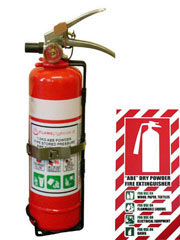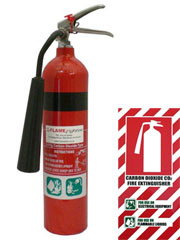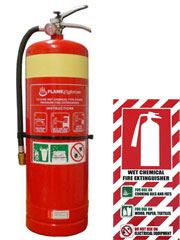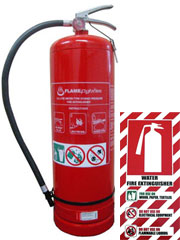What Extinguisher Do I Need?
Dry Powder
Multi purpose dry chemical, covers all normal classes of fire ABE
- 0.3kg DP: for use on motorbikes, chainsaws & lawnmowers etc.
- 1kg DP: for use in camper vans, cars, small domestic kitchens
- 1.5kg DP: for use on buses, small kitchens, service vans etc.
- 2kg DP: for use in office areas, kitchens, small trucks, home garage or workshop, retail shops etc.
- 2.5kg DP: for use in small commercial workshops, kitchens office areas, medium sized trucks etc. & storage areas within 210 Sq Metres
- 4.5kg DP: for use in workshops, large offices, warehousing, larger trucks etc.
- 6kg DP: for use in workshops, large offices, warehousing etc.
- 9kg DP: same as 4.5dp but also fuel stations, bigger warehouses, workshops or dangerous goods store etc.
Carbon Dioxide
Carbon dioxide covers electrical, fuel and flammable liquids fires, advantage is no residue
- 2kg CO2: for use in small workshops, welding areas, service bays for vehicles, server or computer rooms
- 3.5kg CO2: same as above but more capacity
- 5kg CO2: same as above but more capacity again
The selection of an appropriate extinguisher is related to the assessment of risk. This assessment is often difficult in areas outside of those covered by codes of compliance. The assessment of risk is particularly difficult when it comes to protecting items that are operated outside of the usual suburban environment.
The factors, which must be considered in these situations, include the availability of support services such as the Fire Service etc. This is very important with the increase in boating and 4WD activities. Far too often we see the attempt to cover boats and vehicles worth $30,000 - $40,000 with an under-rated $50.00 extinguisher.
This selection guide is offered only to assist in the selection of extinguishers. It is not to be viewed as replacing any compliance codes, building codes or any legislation, which may at any time direct the installation of any particular extinguisher.
The following table sets out a guide for selection on type of extinguisher suitable for the classes of fires. YES in RED indicates that the class in which the extinguishing agent is most effective, LIMITED indicates that the extinguisher is not the ideal choice, but may have some extinguishing capability.
| Extinguishant | Class A Water paper plastics |
Class B Flammable liquids |
Class C Flammable gasses |
Class E Electrically energised equipment | Class F Cooking oils and fats | Comments |
|---|---|---|---|---|---|---|
| Water | YES | NO | NO | NO | NO | Dangerous if used on flammable liquid, energised electrical equipment and cooking oil/fat fires |
| Wet Chemical | YES | NO | NO | NO | YES | Dangerous if used on energised electrical equipment |
| Foam | YES | YES | NO | NO | LIMITED | Dangerous if used on energised electrical equipment |
| ABE Powder | YES | YES | YES | YES | NO | Look carefully at the extinguisher to determine if it is a BE or ABE unit as the capability is different |
| Carbon Dioxide (CO2) | LIMITED | LIMITED | LIMITED | YES | LIMITED | Not suitable for outdoor use |
Further information can be found at the Fire Protection Association of New Zealand website.




